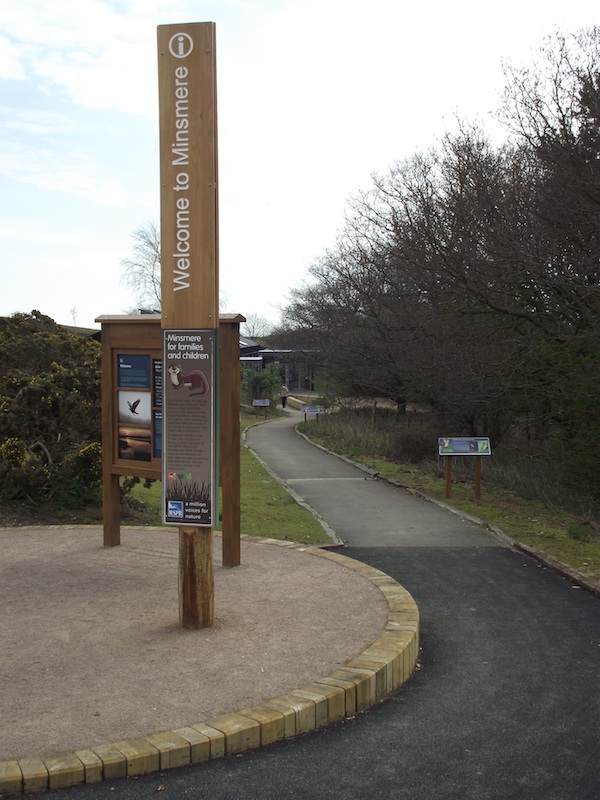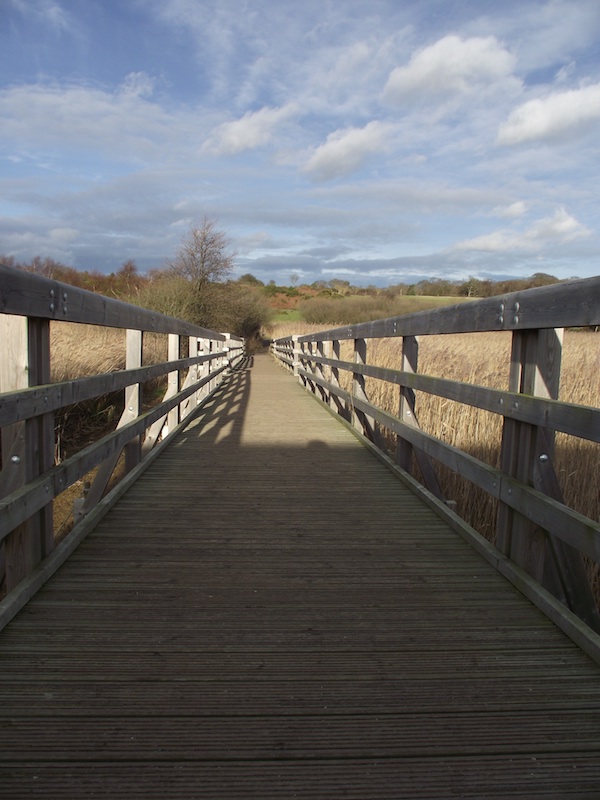Reserve Name: Minsmere RSPB
Address: Minsmere Reserve, Westleton, Saxmundham, Suffolk IP17 3BY
RSPB HQ: The Lodge, Potton Road, Sandy, Bedfordshire SG19 2DL Tel: 01767 680551
Phone Number: 01728 648281 (Visitor Centre) 01728 648780 (Office)
Email: minsmere@rspb.org.uk
Opening Hours: The car park, hides and countryside walks are open from dawn to dusk every day, except 25 and 26 December.
The visitor centre and shop are open daily 9 am-5 pm from February-October, and 9 am-4 pm between November-January. The café is open 9.30 am-4.45 pm from February-October, and 10 am-3.30 pm from November-January.
Charges: A carer or essential companion is admitted free with a disabled visitor. Mobility scooters and manual wheelchairs are available to borrow, ring ahead to check availability and book in advance. Guidedogs only.
RSPB Members are free.
Adults £9, children (under 19) £5, Under 5s free, students £6, family offer: one child free with two paying adults.
Mobility Scooters: There are 3 (three) mobility scooters available to hire… pre-booking is recommended.
Website: Minsmere
Map Reference: TM473672
Google Map: Minsmere REPB Reserve
Assessed by Elizabeth Guntrip March 2017
Photographs by Ian Barthorpe – Visitor Experience Officer Minsmere RSPB
Entrance from the car park
Overview
There’s so much to see and hear at Minsmere: splendid woodland, adjacent heath, wetland and coastal scenery, rare birds breeding and calling in on their migrations, shy wildlife like otters, the booming call of bitterns in spring, beautiful bugs and colourful wild flowers in summer.
RSPB Minsmere is a fantastic coastal nature reserve that’s perfect for families. There’s something to suit everyone at Minsmere. Visitors with little ones and those with mobility problems can enjoy shorter walks along buggy-friendly paths, while able-bodied walkers can stride out along the longer, wilder trails or shell-speckled beach.
Minsmere is home to a staggering variety of wildlife. Keep your voice to a whisper as you scan for secretive bitterns in the reeds. Look out for elegant, black and white avocets – the RSPB emblem! – feeding in flat wetlands. And, if you’re lucky, you may spot otters from the Island Mere Hide. Adders, lizards and water voles also make their homes on the reserve.
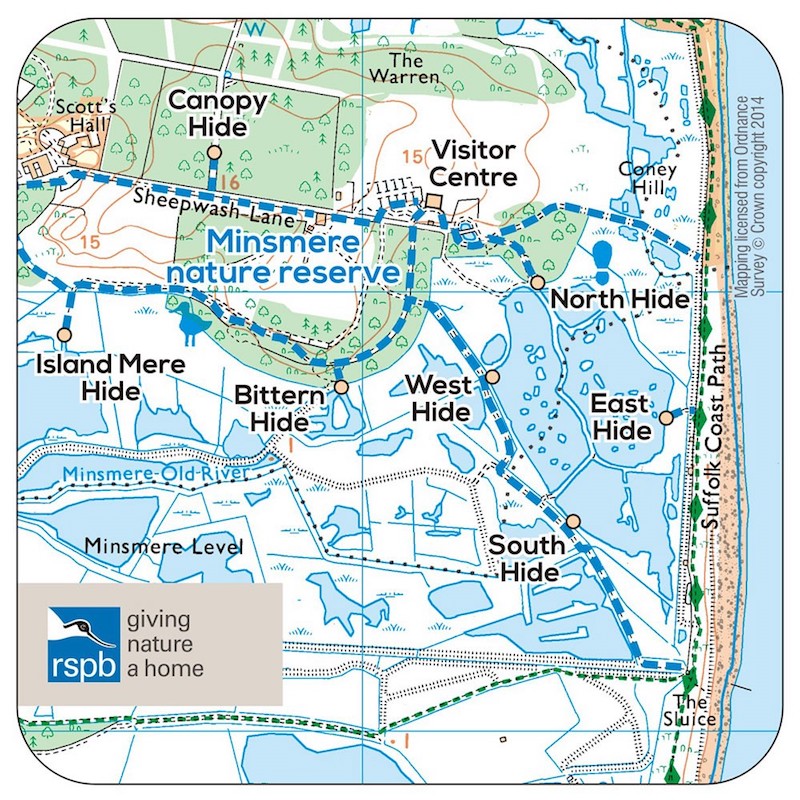
BFA View
RSPB Minsmere is becoming increasingly accessible for visitors with disabilities. Recent work has improved the quality of the accessible routes, which has been described above.
There is no piped music playing in the shop, the café, the toilets, the visitor centre or any of the hides. At the café, staff can bring food trays to customer’s tables, but space around the counter can be quite tight. The café caters for visitors with different dietary requirements, just ask or ring ahead if there are any questions.
The reserve is worth visiting throughout the year. In winter, waders, wildfowl and wintering rarities occupy the scrape; in summer the bird life remains outstanding, as does the range of wild flowers, reptiles, dragonflies and other insects. The reserve is very child-friendly with a ‘Discovery Zone’, ‘Wild Zone’ and adventure activities available.
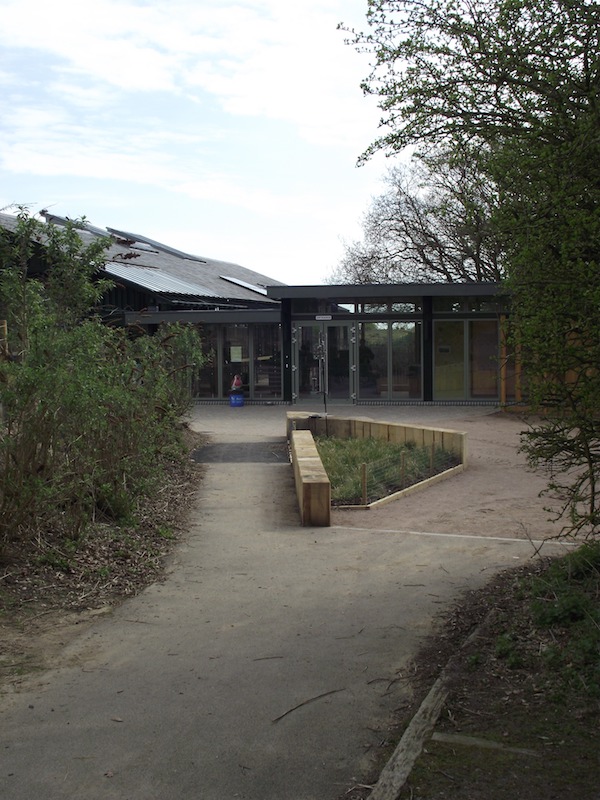
The New Visitor Centre
The reserve is staffed at the visitor centre and café during seasonal hours (see above), and there are also wardens around the reserve, and often ‘Volunteers in the Hides’ who can give help and information at any time. Staff carry radios to allow communication across the reserve.
Minsmere is accessible in most weather conditions. If raining, gravel paths may be a more slippery.
Public Transport Links: RSPB Minsmere is situated on the East coast at Suffolk. Darsham is the nearest train station, located 5 miles from Minsmere. The nearest bus stop is at Leiston, 4 miles from Minsmere. The Minsmere website indicates a shuttle bus can be arranged from these bus and train stations (7am to 7pm Monday to Saturday) providing wheelchair accessible transport, but must be booked at least the day before by calling Suffolk Links Blyth on 01728 833526.
Parking: RSPB Minsmere has free-of charge accessible, extra wide parking spaces for blue badge holders. These are located near to the visitor centre (80 metres from visitor entrance). Accessible car park spaces are indicated next to the entrance to the bay for Blue Badge holders. There is a drop-off point outside the visitor centre, but beware of vehicles and pedestrians. There are parking spaces for two large coaches. The car park surface is gravel, it can be bumpy, but a sturdy tarmac ramp path from the accessible car park spaces leads to the visitor entrance. The car park is not artificially lit.
Toilets: There are three accessible toilets. These are located at the shop; at the outdoor toilet block near the entrance and at the Discovery Centre. Toilets are open during the reserve’s opening hours.
Access
Also see the Minsmere Accessibility page for Minsmere and the Minsmere Access Statement
Visitor Centre
The visitor centre is fully accessible by wheelchair. It has ground-level access, no stairs and tiled floors. Volunteers or staff can help open doors if necessary, but, particularly in warm weather, doors are often propped open.
There is a portable hearing loop at the visitor centre by the shop till.
Ask the staff at the information desk for information for disabled visitors. Visitors are usually offered a free map on arrival, as well as an A4 list of the day’s wildlife sightings. Also, see online access statement.
Information blackboards with white chalk writing feature special events, sightings and other information. There is a large map, with magnetic pictures of species that can be attached to indicate positions of sightings. Other leaflets and information are available too.
Trails
There are four main accessible nature trails from the visitor centre, but all contain sections that may be more difficult to negotiate.
Coast Trail
The Coast trail, is estimated to be about 0.4 miles from visitor centre to the edge of the reserve, heading east. Visitors follow the ramps from the visitor centre past the ponds and North bushes and out to the North Wall. To return, wheelchair users are advised to reverse their route, as the path adjacent to the coast (which loops round The Scrape) is not very accessible. Branching out from the path to the North Wall, a path to the North hide offers views of the scrape.

North Hide View
The ramps leading from the Visitor Centre and across the ponds to the North bushes are a mixture of solid tarmac and sturdy boardwalk. The path to the start of the North Wall (through the North bushes) can be shaded, bumpy and muddy, similar to the wooded habitats, but once out on the North Wall the path is smooth flat and sturdy. Along the North Wall, the path surface is solid, and compact, with a thin sandy overlay.
The paths to the North Wall are estimated to be about 1000mm+ wide.
The ramps leading from the visitor centre to the ponds are at a medium gradient, with an estimated length of 60 metres. There is a shallow upward incline leading out onto the North Wall as the trail here is raised above the reedbeds (to allow all visitors to be able to look across and down into the reeds and pools).
There is no noticeable camber on any of the accessible paths. It should not cause any problems for wheelchair users.
There are no surface breaks along the paths. Bridges contains boards perpendicular to direction of travel, but gaps between these are small and should not cause any problems. Stones on paths in the North bushes section may protrude.
There are no barriers on the path leading to the North Wall.
There is not usually any overhanging branches below a height of 2 metres. All main paths have a width of around 1 metre.
Passing places estimated about 100 metres apart.
The distance between resting places on the most accessible parts of the trail are 100-200 metres. There are two benches on this path.
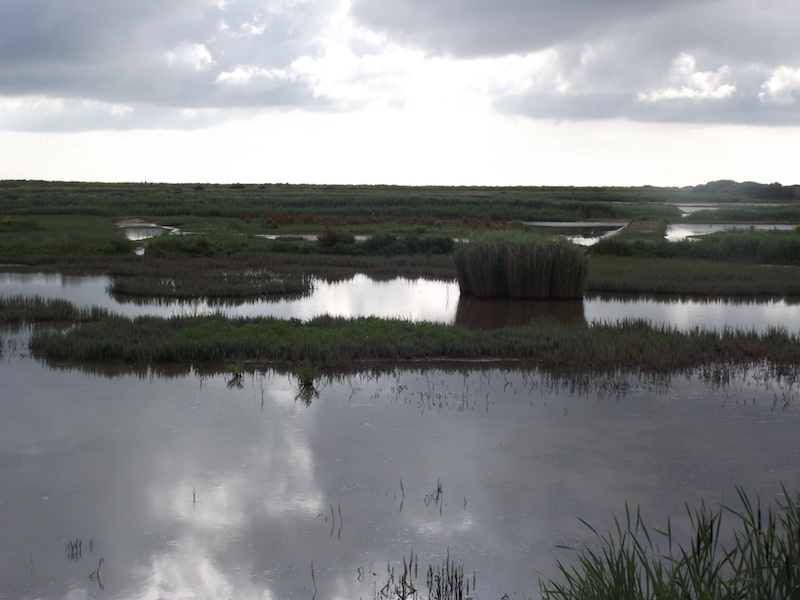
West Scrape
Island Mere Trail

Island Mere with Hide
The Island Mere trail is most easily accessible from a car park lay-by at the top of the path (situated opposite Scotts Hall Holiday Cottage). This means visitors travel only 0.2 miles to reach the Island Mere hide. The path here passes through riparian woodland.

(The full trail travelling to and from the visitor centre through the woodland, perpendicular to the road along the bottom of Whin Hill, to reach the Island Mere hide is about 0.7miles.)
The path from the car park lay-by to the Island Mere hide is rolled gravel, sometimes stony.
Most main paths are estimated to be about 1000mm+.
The trail from the car park lay-by to the hide travels gently downhill. At the entrance to the Island Mere hide, a boardwalk with medium gradient leads up to the hide door. (The rest of the trail has a mix of undulating gradients that can be steep.)
There is no noticeable camber on any of the accessible paths. It should not cause any problems for wheelchair users.
There are no surface breaks along the paths. The boardwalk bridge leading up to the hide contains boards perpendicular to direction of travel, but gaps between these are small and should not cause any problems. Stones on less accessible section of the trail may protrude.
There are no physical protruding barriers.
There is not usually any overhanging branches below a height of 2 metres. Reeds from either side of the path may bend into the path slightly.
The distance between passing places can be over 100 metres on some parts of the trail. The distance between resting places on the most accessible parts of the trail are 100-200 metres.
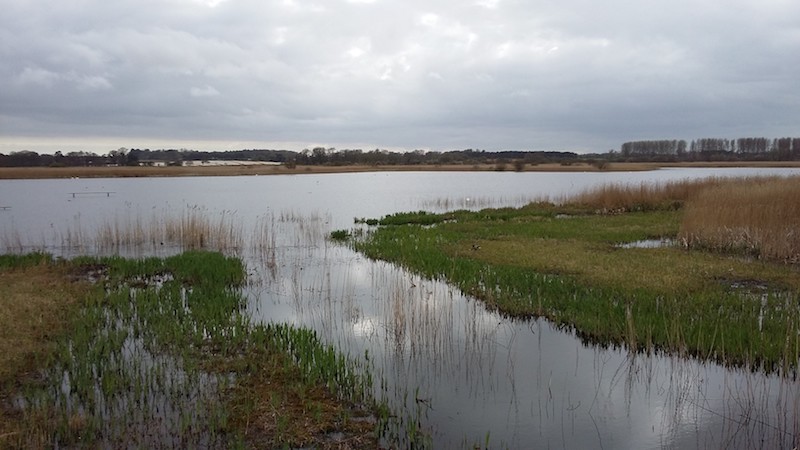
Hides
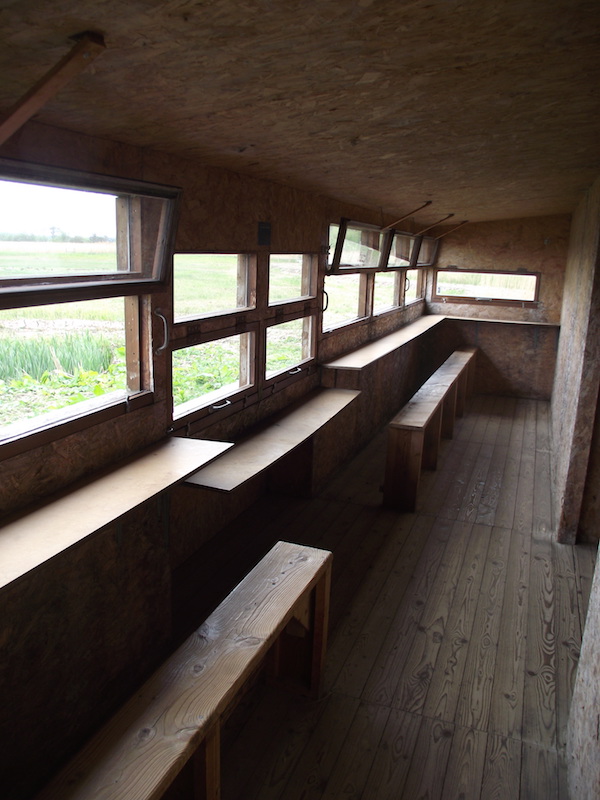
North Hide
The North hide, Wildlife Lookout hide and Island Mere hide are structured similarly, as described below. These are the accessible hides on the most accessible trails. The remaining hides (East hide, Canopy hide and Bittern hide) have up to 70 steps at entrance.
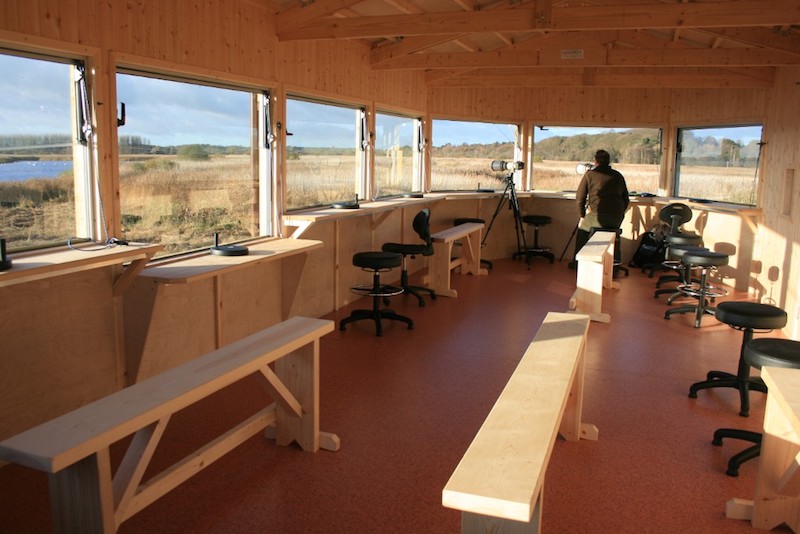
Inside the Island Mere Hide
All paths approaching the accessible hides are flat, compact earth or rolled gravel. There is a small boardwalk section at entrance.
Entrances to the North hide, Wildlife Lookout hide and Island Mere hide are step free.
Some hide doors pull open outwards, with a lever handle. Hide doors are not heavy and doors can sometimes be propped open.
Hides doors are between 850 – 940mm wide.
The North hide, Wildlife Lookout hide and Island Mere hide all have space for wheelchairs, and the Island Mere hide contains movable benches too.
Hide windows are approximately 1+ metres in width.
Some hide windows have wheelchair viewing slots.
The North hide, Wildlife Lookout hide and Island Mere hide contain lower windows, with wheelchair viewing slots. Windows are positioned 935mm from the floor.
Windows are estimated to be a minimum of 380mm glass height.
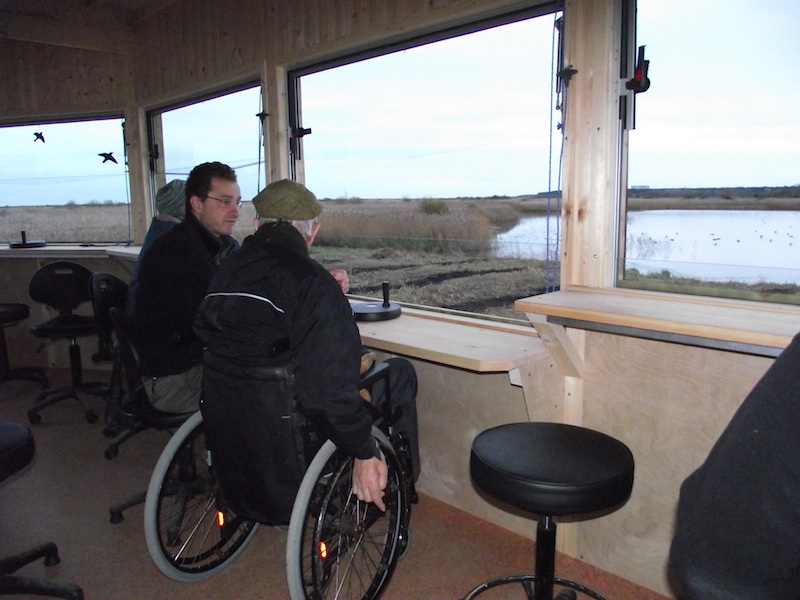
Wheelchair space, Island Mere Hide
Hide windows can be quite heavy and open inwards and upwards. In wheelchair viewing slots these can be opened from a seating position. With the exception of the Island Mere hide, seating in hides is fixed. Hide seats do not contain back rests. Elbow rests are below the windows. Only the Island Mere hide has moveable seats and different styles of benches and stools.
Some hides contain steps leading to the upper level. There is enough space to move past these in a wheelchair.
Boardwalks & Bridges
The start of boardwalks, from tarmac to boardwalk, may have a small lip in some places. Boardwalks are in good condition.
Boardwalks are usually used over waterways. They are estimated to be over 2 metres wide. There is space for wheelchair users to pass with the exception of the short ramp to Island Mere.
The boards are at right angles to the direction of pedestrian flow.
There are gaps between boards but these are estimated to be about 11mm wide. Boardwalks overlaid with non-slip netting. Non-slip treatment is provided by grooves in the boardwalks running perpendicular to the direction of pedestrian flow. The boards are completely stable and non springy. The whole structure is completely sturdy. Leaves or reeds may occasionally lean against the boards.

Boardwalks on trails to the North hide and Island Mere hide have high sides made from sturdy wooden beams (with viewing gaps) forming an impassable barrier. The lowest beam is over 75mm in height. These line the boardwalks and the total height of the barrier is about 1.2 metres.
Handrails are present at locations where there a steeper gradients etc.
The boardwalk leading to the Island Mere hide has a passing place for wheelchairs. Boardwalks on accessible routes are not longer than about 15 metres.


